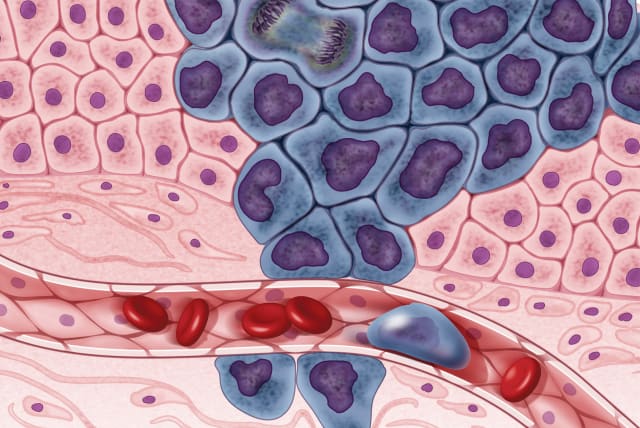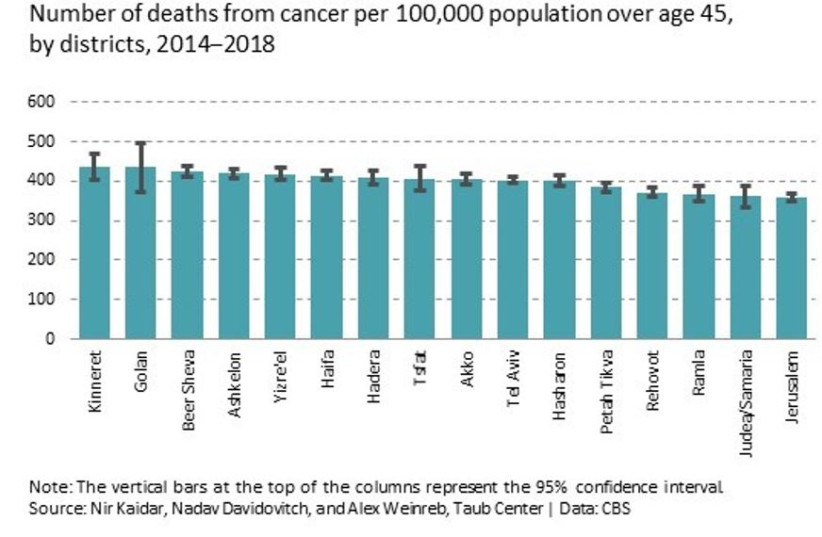Where in Israel are the cancer rates higher or lower?

Researchers examined differences in cancer morbidity and mortality in Israel from three different angles.
Cancer diagnoses are not spread evenly in the country. There are localities where the rate is low and others where the rate is high. In recognition of World Cancer Day held last month, Jerusalem’s Taub Center for Social Policies published a study on “Trends and Gaps in Morbidity and Mortality from Cancer within Towns in Israel.”
Taub Center researchers Nir Kaidar, Prof. Nadav Davidovitch and Prof. Alex Weinreb examined morbidity and mortality rates for cancer in Israel between 2014 and 2018 from three distinct perspectives: the national level, by gender, and by geographic and urban area.
Differences between men and women
Although the findings indicate improving trends with regard to some types of cancer, there is a distinct rise in lung cancer rates among women. They also found differences in disease and death trends between women and men due to exposure to risk factors and differences in health behaviors like smoking, nutrition, and exercise, among other reasons.
Taub Center researchers stress that from the geographic-and-urban-level perspective, there was tremendous importance in the data analysis, since it provides policymakers with a clearer picture of these Israeli trend.
Among towns with a rising rate of new cases of cancer: Kiryat Malachi, Tayibe, Maghar, Migdal HaEmek and Ma’alot-Tarshiha, while the greatest cancer-rate declines were in Tamra, Zichron Ya’akov, Hod Hasharon, Kfar Saba and Karmiel. Among women, the five places with the greatest increase in rates were Kiryat Malachi, Tira, Acre, Rahat and Bat Yam, while the greatest decreases were in Beit Shemesh, Sderot, Yokne’am Illit, Ramat Gan and Ramat Hasharon.
Especially low mortality rates were seen in the districts of Jerusalem, Judea and Samaria, Ramla, Rehovot and Petah Tikva. National-level data indicate a decline in mortality rates among those under age 45. Between 2012 and 2016, an average of 412 men and women per 100,000 population died from cancer, and between 2015 and 2019, this number decreased to 397.
Better-off towns have lower cancer mortality
A look at mortality levels and indices of socioeconomic status reveals that towns with a higher socioeconomic ranking have lower cancer mortality rates than expected, considering their rates of new cases, while in less well-off towns, there are higher than expected mortality rates given their number of new cases.
Davidovitch commented: “Morbidity and mortality from cancer is one of the outstanding challenges facing healthcare systems, including that in Israel. The disparities in morbidity and mortality generally reflect the gaps between population groups, but there are also significant gaps from a geographic and town level perspective that are worthy of further study."
"A better understanding of morbidity and mortality factors – of the influence of the environment, awareness, and health behaviors, as well as access to healthcare services for preventive care, early diagnosis, and treatment – affords better, more targeted interventions with the disease,” he added.
Jerusalem Post Store
`; document.getElementById("linkPremium").innerHTML = cont; var divWithLink = document.getElementById("premium-link"); if (divWithLink !== null && divWithLink !== 'undefined') { divWithLink.style.border = "solid 1px #cb0f3e"; divWithLink.style.textAlign = "center"; divWithLink.style.marginBottom = "15px"; divWithLink.style.marginTop = "15px"; divWithLink.style.width = "100%"; divWithLink.style.backgroundColor = "#122952"; divWithLink.style.color = "#ffffff"; divWithLink.style.lineHeight = "1.5"; } } (function (v, i) { });

